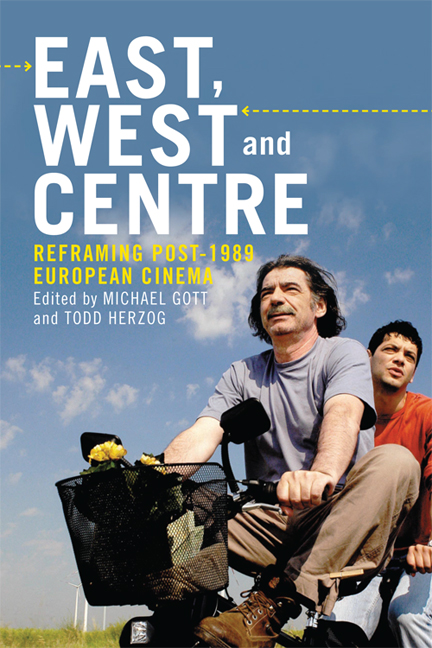Book contents
- Frontmatter
- Contents
- List of Figures
- Notes on Contributors
- Acknowledgements
- Introduction: East, West and Centre: ‘Mapping Post-1989 European Cinema’
- Part I Redrawing the Lines: De/Recentring Europe
- Part II Border Spaces, Eastern Margins and Eastern Markets: Belonging and the Road to/from Europe
- Part III Spectres of the East
- Notes
- Bibliography
- Index
Introduction: East, West and Centre: ‘Mapping Post-1989 European Cinema’
Published online by Cambridge University Press: 05 September 2016
- Frontmatter
- Contents
- List of Figures
- Notes on Contributors
- Acknowledgements
- Introduction: East, West and Centre: ‘Mapping Post-1989 European Cinema’
- Part I Redrawing the Lines: De/Recentring Europe
- Part II Border Spaces, Eastern Margins and Eastern Markets: Belonging and the Road to/from Europe
- Part III Spectres of the East
- Notes
- Bibliography
- Index
Summary
Eastern and Western Europe Twenty-five Years after the Fall of the Wall
The fall of the Berlin Wall and the subsequent expansion of the European Union and creation of the Schengen Zone opened the gates for what have been termed ‘new migrations’ (Mazierska and Rascaroli, 140). By 1994, an estimated four million people had migrated across the newly opened borders – and this number does not even include the millions who fled war in the former Yugoslavia or the one million Poles who headed west in the three years that followed their nation's 2004 entry into the European Union (Castles and Miller, 116). Though political borders between Eastern and Western Europe have become much more open and fluid, mental borders still divide the continent along the old Cold War lines. Despite their newly gained access to Western Europe, ‘Eastern’ Europeans have been relegated at times to a second-class status in Western Europe, as the ‘Polish Plumber’ rhetoric so prevalent during the 2005 French referendum on the EU Constitution demonstrates (Raissiguier, Skrodzka 2011, Gott 2013c). As we approach the twenty-fifth anniversary of the fall of the Berlin Wall and an entire post-Wall generation has entered adulthood, it is an appropriate time to assess the ways in which notions of an Eastern and Western Europe still exist as well as the ways in which a new/old notion of Central Europe has re-entered public discourse and the popular imagination. More recently, factors such as the economic crisis in Europe have underscored increasingly visible north–south fault lines.
To pursue this investigation, this volume turns to European cinema which has been a vibrant space in which to understand and work through notions of and beyond national borders. The fact that a new journal, with the title Studies in Eastern European Cinema, was launched in 2010 demonstrates that more than twenty years after the fall of the Berlin Wall, the ‘Eastern’ label continues to be a valid paradigm. And given that a new journal with the title Studies in Western European Cinema would be inconceivable today indicates that the East remains in many ways Western Europe's ‘other’. In one line of thinking, Western Europe is Europe, while Eastern Europe finds itself in uncertain ground that is not quite European.
- Type
- Chapter
- Information
- East, West and CentreReframing post-1989 European Cinema, pp. 1 - 20Publisher: Edinburgh University PressPrint publication year: 2014



